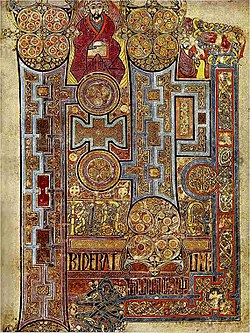Gospel Book

A Gospel Book, Evangelion, or Book of the Gospels (
Liturgical use in churches of a distinct Gospel book remains normal, often compulsory, in
History

In the
But most Gospel Books were never illuminated at all, or only with decorated
Luxuriously illuminated gospel books were mainly a feature of the Early Middle Ages, as the evangeliary or a general lectionary gradually became more common for liturgical use, and other texts became most favoured for elaborate decoration.[7]
Western use
Roman Catholicism
In current
The Book of the Gospels, if used, is brought to the altar in the entrance procession, while the Lectionary may not be.[10] When carried in procession, the Book of the Gospels is held slightly elevated, though not over the head. It is particularly proper for the deacon to carry the Book of the Gospels in procession, as the reading of the gospel is his particular province. When there is no deacon, the Book may be carried by a lector.[11] Upon reaching the altar, the deacon or lector bows in veneration of the altar, then places the Book upon the altar, where it remains until the Alleluia.[12]
During the singing of the Alleluia, the deacon (who before proclaiming the gospel receives the presiding priest's blessing), or in his absence, a priest, removes the Book from the altar and processes with it to the ambo. If incense is used, the Book of the Gospels is censed by the deacon before the reading or chanting. An altar server or acolyte will swing the censer slowly during the reading or chanting.[13] The Book of the Gospels remains on the ambo until the Mass concludes, unless it is taken to a bishop to be kissed, after which it may be placed on the credence table or another appropriate and dignified place.[14]
Lutheranism
In the Lutheran Churches, the Book of the Gospels is "carried in procession".[15][16]
Anglicanism

In the
Eastern use
This section is empty. You can help by adding to it. (February 2023) |

Significant gospel books

See also the categories at bottom.
- Rossano Gospels
- Rabula Gospels
- Mulling Gospels
- Book of Durrow
- Domnach Airgid
- Echternach Gospels
- St. Augustine Gospels
- Stonyhurst or St Cuthbert Gospel (St John only)
- Durham Gospels
- Lindisfarne Gospels
- Lichfield Gospels (also known as the St. Chad Gospels)
- Leningrad Gospels
- Book of Kells
- Barberini Gospels
- Vienna Coronation Gospels
- Aachen Coronation Gospels
- Ada Gospels
- Ebbo Gospels
- Codex Aureus of St. Emmeram
- Lorsch Gospels
- Codex Aureus of Echternach
- Emperor's Bible
- Gospels of Henry the Lion
- Miroslav Gospels
- Gospels of Tsar Ivan Alexander
- Peresopnytsia Gospels
Notes
- ^ a b "General Instruction of the Roman Missal, 44" (PDF). Catholic Bishops' Conference of England & Wales. Catholic Truth Society. Retrieved 2 February 2015.
Among gestures included are also actions and processions: of the priest going with the deacon and ministers to the altar; of the deacon carrying the Evangeliary or Book of the Gospels to the ambo before the proclamation of the Gospel ...
- ^ Calkins, 31
- ^ Calkins, 18-19
- ^ Calkins, 23-29, and chapters 1 and 3
- ^ Calkins, chapters 1 and 3 deals with these in turn
- ^ Calkins, 25
- ^ Calkins, 148-150
- ^ Deiss, 36-37
- ^ ""The Proclamation of the Gospel at Mass" (The Catholic Liturgical Library)". Archived from the original on 2018-04-18. Retrieved 2015-02-02.
- ^ General Instruction of the Roman Missal, 120
- ^ Deiss, 38-39
- ^ Commentary, 128
- ^ Paul Turner, "The Book of the Gospels"
- ^ Edward McNamara, "A Place for the Book of the Gospels"
- ^ Eckardt, Burnell; Frahm, John A. (6 July 2017). "Give Attention to the Public Reading of Scripture: I Timothy 4:13: Lectors, Pastoral Stewardship, and Gender Considerations". Gottesdienst: The Journal of Lutheran Liturgy. Retrieved 8 October 2023.
- ISBN 978-1-108-49092-4.
- ^ 1979 US Book of Common Prayer, p. 406
References
- Calkins, Robert G. Illuminated Books of the Middle Ages. 1983, Cornell University Press, ISBN 0500233756
- "Commentary", Edward Foley, John Francis Baldovin, Mary Collins, Joanne M. Pierce, eds., A Commentary on the Order of Mass of the Roman Missal, 2011, Liturgical Press, 2011, ISBN 0814662471, 9780814662472
- ISBN 0814620582, 9780814620588
- Otto Pächt, Book Illumination in the Middle Ages (trans fr German), 1986, Harvey Miller Publishers, London, ISBN 0199210608
- Palazzo,Eric, A History of Liturgical Books from the Beginning to the Thirteenth Century, 1998, Liturgical Press, ISBN 081466167X, 9780814661673, google books
External links
- Getty Museum feature on gospel books, and another
- Photo of Orthodox deacon holding Gospel Book
- Photo of Paschal Liturgy (the Gospel Book can be seen lying on the Epitaphios)
- Reading the Gospel at All-Night Vigil
- Photo of Confession
- Photo of Gospel Book enthroned at council
- Photo of deacon reading the Gospel
- Funeral of an Orthodox Bishop (St. John Maximovitch) showing Gospel Book in coffin
- Jewelled Gospel book-Romanov collection at the Alexander Palace
